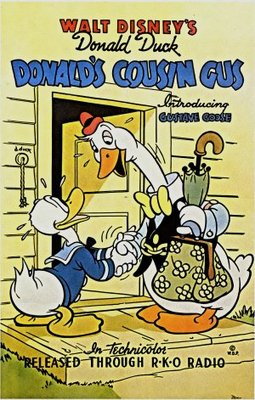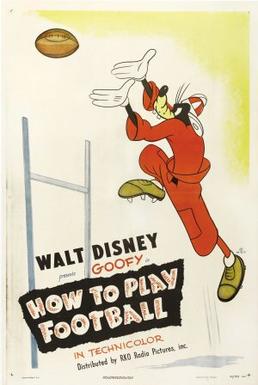
Oswald the Lucky Rabbit is an animated cartoon character created in 1927 by Walt Disney and Ub Iwerks for Universal Pictures. He starred in several animated short films released to theaters from 1927 to 1938. Twenty-seven animated Oswald shorts were produced at the Walt Disney Studio. After Universal took control of Oswald's character in 1928, Disney created a new character similar in appearance to Oswald as a replacement: Mickey Mouse, who went on to become one of the most famous cartoon characters in the world.

Goofy is a cartoon character created by The Walt Disney Company. He is a tall, anthropomorphic dog who typically wears a turtle neck and vest, with pants, shoes, white gloves, and a tall hat originally designed as a rumpled fedora. Goofy is a close friend of Mickey Mouse and Donald Duck, and is Max Goof's father. He is normally characterized as hopelessly clumsy and dim-witted, yet this interpretation is not always definitive; occasionally, Goofy is shown as intuitive and clever, albeit in his own unique, eccentric way.

Who Framed Roger Rabbit is a 1988 American fantasy comedy film directed by Robert Zemeckis from a screenplay written by Jeffrey Price and Peter S. Seaman. It is loosely based on the 1981 novel Who Censored Roger Rabbit? by Gary K. Wolf. The film stars Bob Hoskins, Christopher Lloyd, Stubby Kaye, Joanna Cassidy, and the voice of Charles Fleischer. Combining live-action and animation, the film is set in an alternate history Hollywood in 1947, where humans and cartoon characters co-exist. Its plot follows Eddie Valiant, a private investigator with a grudge against toons, who must help exonerate Roger Rabbit, a toon framed for murder.

Chip and Dale are a cartoon duo of anthropomorphic chipmunks created in 1943 by The Walt Disney Company.

Donald's Cousin Gus is a Walt Disney cartoon released on May 19, 1939. Gus Goose debuted as a recurring character in Al Taliaferro's Donald Duck newspaper comic since 9 May 1938.

The Gallopin' Gaucho is a 1928 American animated short film and the second short film featuring Mickey Mouse to be produced, following Plane Crazy and preceding Steamboat Willie. The Disney studios completed the silent version in August 1928, but did not release it in order to work on Steamboat Willie. It was released, with sound, after Steamboat Willie on December 30 of the same year.

Donald's Nephews is a 1938 Donald Duck animated cartoon which features Donald being visited by his three nephews, Huey, Dewey, and Louie. This cartoon is Huey, Dewey, and Louie's first appearance in animation. Al Taliaferro, the artist for the Silly Symphony comic strip, proposed the idea for the film, so that the studio would have duck counterparts to Morty and Ferdie Fieldmouse, the nephews of Mickey Mouse. The Walt Disney Productions Story Dept. on February 5, 1937 sent Taliaferro a memo recognizing him as the source of the idea for the planned short.

Alice in Wonderland is a 1951 American animated musical fantasy comedy film produced by Walt Disney Productions and released by RKO Radio Pictures. It is based on Lewis Carroll's 1865 novel Alice's Adventures in Wonderland and its 1871 sequel Through the Looking-Glass. The production was supervised by Ben Sharpsteen, and was directed by Clyde Geronimi, Wilfred Jackson, and Hamilton Luske. With the voices of Kathryn Beaumont, Ed Wynn, Richard Haydn, Sterling Holloway, Jerry Colonna, Verna Felton, J. Pat O'Malley, Bill Thompson, and Heather Angel, the film follows a young girl Alice who falls down a rabbit hole to enter a nonsensical world Wonderland that is ruled by the Queen of Hearts, while encountering strange creatures, including the Mad Hatter and the Cheshire Cat.

Mickey's Toontown is a themed land at Disneyland and Tokyo Disneyland, two theme parks operated by Walt Disney Parks & Resorts and The Oriental Land Company respectively. At Tokyo Disneyland, this land is named Toontown. A similar land existed at the Magic Kingdom until 2011 and was named Mickey's Toontown Fair. Walt Disney Studios Park in Disneyland Paris has a related land called Toon Studio.
Walt Disney's Classic Cartoon Favorites is a series of DVDs by Walt Disney Home Entertainment. Each release would feature around one hour of Disney animated short films, grouped by a starring character or a theme. It is based on the original Walt Disney Cartoon Classics line of videotapes of the 1980s. As opposed to the chronological nature of the Walt Disney Treasures line, each release would feature various cartoons in no particular order. The series featured a total of four waves of releases, between January 11, 2005 and April 11, 2006. Another very similar line was Walt Disney's Funny Factory.

Goofy and Wilbur is an animated cartoon short produced by Walt Disney Productions and released by RKO Radio Pictures on March 17, 1939. Although the cartoon is billed as a Mickey Mouse cartoon, it was the first cartoon which featured Goofy in a solo role without Mickey Mouse and/or Donald Duck.
Aquamania is an American animated Goofy cartoon produced by Walt Disney Productions and released by Buena Vista Distribution on December 20, 1961.

How to Play Baseball is a cartoon produced by Walt Disney Productions and released by RKO Radio Pictures in September 1942, featuring Goofy. The short was produced at the request of Samuel Goldwyn and first shown to accompany the 1942 feature film The Pride of the Yankees.

Walt Disney Treasures is a series of two-disc DVD collections of Disney cartoons, television episodes and other material. They cover material from the studio's earliest days to its more recent work. There were nine waves, each containing two to four sets, for a total of 30 titles. All content is presented uncensored and uncut with digitally restored picture and remastered sound.
On Ice is a 1935 theatrical cartoon short in the Mickey Mouse film series, produced by Walt Disney Animation Studios. It was the 79th Mickey Mouse short film to be released, and the eighth of that year.
The second wave of Walt Disney Treasures was released December 3, 2002. This was the final wave with the tin's individual number embossed on the tin.

The Art of Skiing is a Goofy cartoon made by Walt Disney Productions in 1941. It has historical significance as the first cartoon to use the now-famous Goofy holler, as well as the short that led to the "How to..." series, beginning with How to Play Baseball (1942) and continuing through How to Hook Up Your Home Theater (2007).

How to Play Football is an animated comedy short film by Disney starring Goofy, released on September 15, 1944. The short was directed by Jack Kinney. The seven and a half minute film was nominated for an Academy Award for Best Animated Short Film, but lost to the Tom and Jerry cartoon Mouse Trouble by MGM.

Roger Rabbit is a fictional animated anthropomorphic rabbit. The character first appeared in author Gary K. Wolf's 1981 novel, Who Censored Roger Rabbit? In the book, Roger is second banana in a popular comic strip, "Baby Herman". Roger hires private detective Eddie Valiant to investigate why his employers, the DeGreasy Brothers, have reneged on their promise to give Roger his own strip. When Roger is found murdered in his home, Valiant sets out to look for the killer, with the help of Roger's "doppel".

Goofy is a series of American animated comedy short films produced by Walt Disney Productions. The series started in 1939 with Goofy and Wilbur and ended in 1953 with How to Sleep. An additional short, How to Hook Up Your Home Theater, was released in 2007. The series stars the titular character Goofy, introduced in the short film series Mickey Mouse as one of Mickey's friends.
















